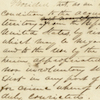
Congress Debates the Fate of the Nation
Summary
Students will study the issue of sectionalism after the war with Mexico by analyzing the Wilmot Proviso and an 1848 map of the United States that was created for President James K. Polk to inform Congress about the newly acquired Western territories.
Rationale
The Wilmot Proviso (first passed by the House of Representatives in 1846) and the map of the United States created to accompany President Polk’s 1848 Annual Message to Congress presented two proposals for resolving the free or slave status of the newly acquired Western territories, initiating the congressional debate that produced the Compromise of 1850. While the compromise preserved the Union for several years, the unresolved issue of slavery in Western territory, ultimately, triggered the Civil War.
Guiding Question
How did the Wilmot Proviso and the Map of the United States that Accompanied President Polk’s 1848 Annual Message influence the 1850s congressional debate over slavery in the newly acquired Western territories?
Materials
Facsimile: The Wilmot Proviso and transcript
Recommended Grade Levels
Grades 8-12
Courses
U.S. History
Vocabulary
James K. Polk, Wilmot Proviso, Compromise of 1850, Annual Message to Congress, Mexican War
Featured Document
 Wilmot Proviso, August 8, 1946; Bills and Resolutions Originating in the House; Records of the U.S. House of Representatives, RG 233; National Archives, Washington, DC. View in National Archives Catalog
Wilmot Proviso, August 8, 1946; Bills and Resolutions Originating in the House; Records of the U.S. House of Representatives, RG 233; National Archives, Washington, DC. View in National Archives Catalog
 Map of the United States Including Western Territories, December 1848; Office of the Clerk of the House; Records of the U.S. House of Representatives, RG 233; National Archives, Washington, DC. View in National Archives Catalog
Map of the United States Including Western Territories, December 1848; Office of the Clerk of the House; Records of the U.S. House of Representatives, RG 233; National Archives, Washington, DC. View in National Archives Catalog
Time Required
Each activity requires about 30 minutes.
Learning Activities
1. Analyzing the Wilmot Proviso
- Divide the class into small groups. Distribute or display the Wilmot Proviso facsimile and transcript, Polk Map facsimile, and Worksheets 1, 2, and 3.
- Direct each group to study the Wilmot Proviso using Worksheet 1.
- Students will complete Worksheet 2 in two parts. Direct each group to answer question 1, “What did the Wilmot Proviso say about slavery in the newly acquired Western territories?”
- Direct each group to outline and label the following areas of the map printed on Worksheet 3: the Free states, the Slave states, the Northwest Territory, the 36°30’ line of latitude, the Oregon Territory, and the area affected by the Wilmot Proviso. They should use data found on the Polk Map facsimile to complete these items.
- Direct each group to complete the rest of Worksheet 2. Make sure they are prepared to share their response to Question 3 with the class.
2. Analyzing the Map of the United States that Accompanied President Polk’s 1848 Annual Message to Congress
- Divide the class into small groups. Distribute Worksheets 4, 5, and 6.
- Direct each group to use Worksheet 4 to study the Polk Map facsimile.
- Students will complete Worksheet 5 in two parts. Direct each group answer question 1 on Worksheet 5 by contrasting the Polk Map facsimile to a present-day political map of the same region. Note that the present-day map is not included in this lesson. Ask students to list five significant differences between the two maps.
- Direct each group to complete the table on Worksheet 6 by drawing from the statistics printed on the sides of the Polk Map facsimile.
- Direct each group to complete the rest of Worksheet 5. Make sure each group is prepared to share its response to Question 4 with the class.
3. Reflection Questions
- Divide the students into small groups. Distribute Worksheet 7.
- Direct each group to complete wthe worksheet.
- Students should be prepared to share their responses to Questions 4 and 5 with the class.
If you have problems viewing this page, please contact legislative.archives@nara.gov.